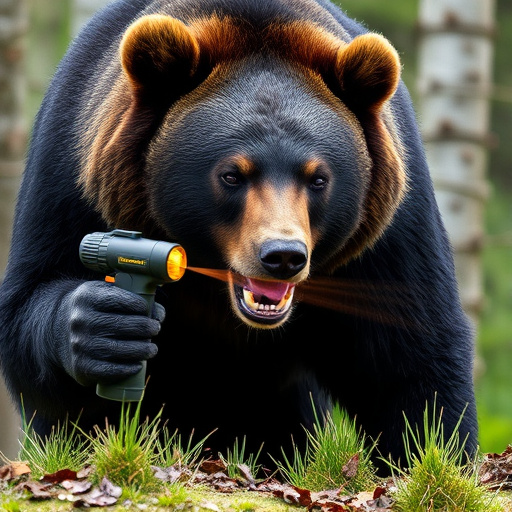Grizzly bears, with their powerful sense of smell, can be unpredictable and may charge as a defense mechanism. Bear repellents containing capsaicin—the heat-inducing compound in chili peppers—disrupt bears' scent detection abilities due to their high concentration (10% to 25%), making them effective deterrents. Concentrations above 10% have proven successful against both black and grizzly bears. Users must follow strict safety guidelines when handling capsaicin-based repellents, which serve as a last resort for mitigating potential threats in bear habitats.
In the vast wilderness, encountering a grizzly bear can be a terrifying prospect. Understanding their behavior and utilizing effective repellents are crucial for safety. This article explores the science behind capsicins, potent compounds derived from chili peppers, as a powerful bear deterrent. We delve into the critical factor of capsicum concentration in bear repellent, offering practical tips for application while emphasizing safety measures to ensure an enjoyable outdoor experience.
- Understanding Grizzly Bear Behavior and Their Sense of Smell
- The Science Behind Capsaicin as a Bear Repellent: How Concentration Matters
- Practical Application and Safety Tips for Using Capsaicin-Based Bear Repellents
Understanding Grizzly Bear Behavior and Their Sense of Smell
Grizzly bears are powerful and unpredictable animals, and understanding their behavior is crucial for anyone venturing into their wilderness habitat. These bears have an exceptional sense of smell, which plays a significant role in their survival and interactions with the environment. They primarily rely on scent to locate food sources, detect potential threats, and communicate with other bears. When it comes to human encounters, grizzlies may charge as a defensive mechanism if they perceive a threat or feel cornered.
The key to defense lies in bearing in mind that grizzly bears have a highly sensitive olfactory system, with a much higher smell detection capacity than humans. This is why repellent methods focusing on the capsaicin concentration in bear repellents can be effective. Capsaicin, the active ingredient in chili peppers, has been shown to disrupt a bear’s sense of smell and create an unpleasant experience, encouraging them to avoid certain areas or individuals. Understanding these behavioral traits and employing appropriate strategies can help minimize conflicts between humans and grizzly bears in their natural habitats.
The Science Behind Capsaicin as a Bear Repellent: How Concentration Matters
Capsaicin, the compound responsible for the heat and irritation sensation in chili peppers, has gained attention as a potent bear repellent. Its effectiveness lies in its ability to disrupt a bear’s sensory perception. Bears have sensitive olfactory systems, and capsaicin can interfere with their scent detection, creating an unpleasant experience.
The key factor is capsaicin concentration; higher concentrations are more effective. Commercial bear repellents often contain capsaicin at varying levels, typically ranging from 10% to 25%. A higher concentration of capsaicin ensures a stronger reaction from the bear, making it an excellent natural defense mechanism for hikers and campers in grizzly bear country. Understanding this science behind capsaicin’s concentration is crucial for those seeking effective bear protection while exploring the wilderness.
Practical Application and Safety Tips for Using Capsaicin-Based Bear Repellents
When it comes to protecting yourself against aggressive grizzly bears, capsaicin-based bear repellents offer a practical and non-lethal solution. These repellents utilize the active ingredient capsaicin, commonly found in chili peppers, which can effectively deter bears when applied correctly. The capsaicin concentration is key; higher concentrations (typically above 10%) have been shown to be more effective against both black and grizzly bears.
For safety, it’s crucial to follow instructions carefully when using these repellents. This includes ensuring proper application, as direct contact with skin or eyes can cause discomfort. Store them out of reach of children and pets, and always carry them in their original packaging. Remember, while capsaicin repellents are powerful deterrents, they should be used as a last resort when faced with an imminent threat from a grizzly bear.
In understanding grizzly bear behavior, we’ve seen that their acute sense of smell is a key defense mechanism. The science behind capsaicin as a bear repellent highlights the importance of concentration – a higher percentage of capsaicin creates an effective barrier. By following practical application tips and prioritizing safety measures, individuals can effectively protect themselves in wild environments. Remember, knowledge of grizzly behavior and the right capsaicin-based repellent with the appropriate concentration are essential tools for navigating these powerful creatures’ habitats.
